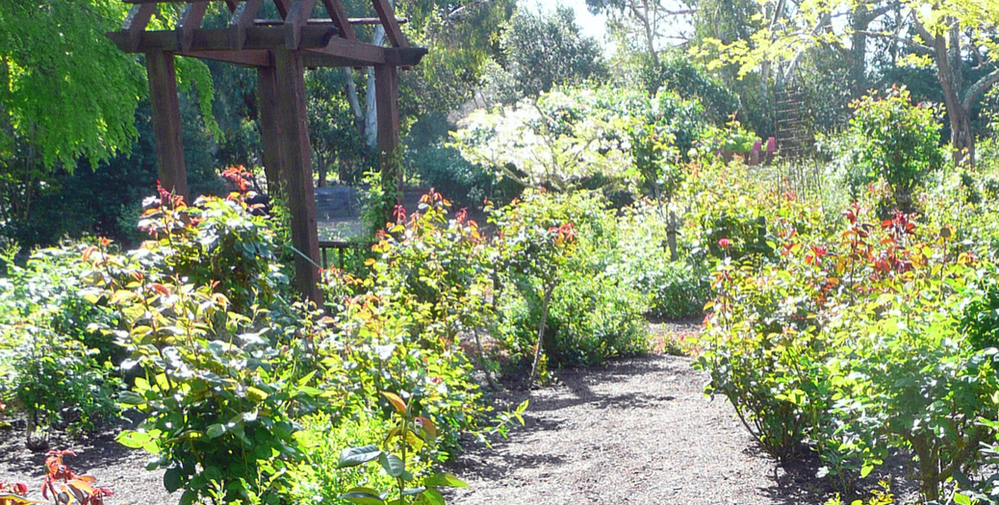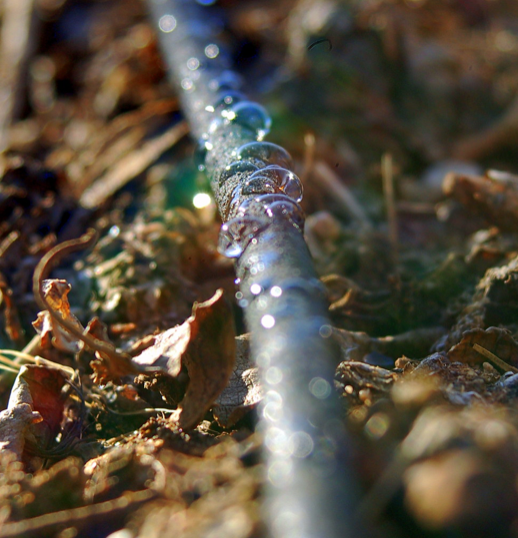by Nanette Londeree, Master Rosarian, Marin County Rose Society

ABOVE: Soil covered with a layer of mulch retains moisture while suppressing weeds, photo by Nanette Londeree.
Drought – it is a scary thing, especially when your only source of water comes from seasonal rains and they don’t materialize. This past winter was the one of the driest in our local history, and now we are mandated to cut back on water use. While roses perform best with ample water, they can make it on much less. The plant may not grow or produce many flowers during the hot summer months, basically going dormant until cooler temperatures arrive, but they will survive.
The volume of water a rose plant needs depends on many variables; the age, size, and location of the plant, the type of soil it is growing in and air temperature, humidity, and wind conditions. Often watered frequently for short amounts of time, garden roses develop shallow roots and have a tougher time during times of reduced water availability, often wilting or exhibiting leaves with brown, dead edges. But it’s not how they start out. Most modern roses are grown in production fields located in super-hot areas like Bakersfield, California and Phoenix, Arizona. They are deeply watered only once per week (furrow irrigation for about half a day), no matter if the temperatures are in the triple digit range for weeks. And they do just fine.
To maximize your water use and keep your roses healthy:
Reduce what you need to water: Take a hard look at your roses – are they all producing the abundance of healthy foliage and blooms you desire, or do you have some that are stingy with flower production and magnets for mildew and other disease? If they fall into the latter camp, give them the boot and shovel prune! Don’t waste precious water on plants that aren’t performing.
Smaller may be better: After the big spring bloom, trim plants back significantly to reduce their overall size. The more foliage on the plant, the more water it will require to keep the plant healthy. You may lose some bloom (it supposedly takes 35 roses leaves to produce one rose blossom), but come fall with its cooler temperatures, you’ll likely get another good crop of flowers.

Leave the leaves: Whether cutting roses for bouquets or deadheading spent blooms, leave as much foliage on the plant as you can. While the leaves require water to stay hydrated, they are the cooling system for the plant. Leaves also provide shade for the base of the plant, potentially reducing moisture loss from the soil. LEFT: Be sure all watering equipment is in good working order; repair any leaks, photo courtesy Wikimedia Commons.
Check your tools: No matter what you use to water your roses, make they’re in good working order. Fix leaky hoses or faucets; check drip irrigation, sprinkler systems, and timing devices regularly to ensure proper operation. If you water by hand, have an on / off valve at the use end and shut the water off when moving between plants.
Timing is important: Water during the early morning hours when temperatures and wind speed are the lowest, and where possible, stretch the interval between irrigations. Roses do best when 50% of available water is depleted between irrigations. Don’t water based on the calendar or a schedule, watch the weather and your plants, and monitor the moisture in the soil.

Technique makes a difference: Water your plants slowly and deeply; apply water only as rapidly as the soil can absorb it. When possible, divide your watering cycle into shorter periods to reduce runoff and allow for better absorption every time you water. Apply water within the “drip line” of the plant (that imaginary line of from the outermost leaves of a plant down to the soil). RIGHT: Drip irrigation is a good way to apply water slowly and deeply, photo courtesy Flicker.
Mulch, mulch, mulch: Add a layer of mulch to the soil to moderate soil temperature, reduce evaporation, and reduce weeds. The amount of mulch you add depends on the texture and density of the material you are using and the quality of drainage of the soil you are covering; a good rule of thumb is two to four inches. Remove weeds first, then carefully spread an even layer of mulch over the soil surface, keeping it a few inches away from the base of the plant.
Forget the fertilizer: Many rose growers apply chemical fertilizers monthly spring through early fall to stimulate growth and flower production. An actively growing plant needs more water. Give the plants a rest through the hot summer months (June – September); keep them hydrated but avoid anything that stimulates growth. If you do fertilize, use an organic material like fish emulsion, that releases nutrients slowly into the soil.
Control weeds: Weeds will compete for precious water. Remove them by hand (and get the entire plant when they are small before they go to seed). Use mulch to prevent them from growing back.
With a little planning and extra care, you can keep your roses alive, while reducing your overall water use. Then come next season, after a winter of “normal” rainfall (we hope), they’ll be ready to perform once more.




























































